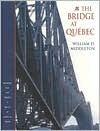The Bridge at Quebec
Review "In this handsome work, civil engineer and historian Middleton traces the history of the Québec (Quebec) Bridge across the St. Lawrence River from its early planning stages in the 1850s, through the construction phase that ended in 1917, and on to the present day. The construction project was a tremendous undertaking, involving the erection of the world's longest cantilevered span. The project was fraught with difficulties, including two of the worst construction accidents in...
Search in google:
In the middle of the 19th century the leaders of the City of Québec dreamed of a great bridge across the St. Lawrence River. It would link their city to the new railway lines developing along the south shore, giving Québec a competitive edge in its long struggle with Montréal for commercial dominance. The width and depth of the St. Lawrence necessitated a bridge of unprecedented scale, and many of the best engineers of the time turned their attention to the problem. Three serious proposals for a bridge never materialized. A fourth plan finally moved ahead at the beginning of the 20th century, only to end in one of the greatest construction failures of all time. In 1907 the incomplete structure collapsed into the river with a loss of 75 lives. From the ruins of this first attempt emerged still another plan. In 1916, when the great bridge was nearing completion, tragedy struck again. As the huge center span was being lifted into place, it fell into the river, taking another 11 lives. It was not until a year later that a replacement was installed, and the great bridge was finally complete. Today the Québec Bridge stands firmly astride the St. Lawrence, safely carrying the commerce of Canada across its broad waters. No one has yet built a longer cantilever span, so the bridge still ranks as the greatest of its kind. The Bridge at Québec provides a full account of the long effort to build a bridge at this difficult site, with particular emphasis on the extraordinary story of the failure of the first one, the human tragedies that accompanied it, and the lessons that its story holds today for engineers and builders as they continue to extend the boundaries of technology. Fully illustrated, the book makes clear to the general reader and technical audiences alike the engineering issues involved in constructing one of the world's greatest bridges.About the Author: William D. Middleton is a 1950 civil engineering graduate from Rensselaer Polytechnic Institute and is a registered Professional Engineer in Virginia and Wisconsin. His professional career has included 29 years as an officer in the U.S. Navy's Civil Engineer Corps and 13 years as chief facilities officer for the University of Virginia. He has also been active as a transportation and engineering historian and journalist, with 16 books and nearly 500 articles to his credit. His published books include a number of titles concerned with the history of electric railways and rail transit in North America, and histories of New York's Grand Central Terminal and Pennsylvania Station. He has written about electric railways, cable cars, and Penn Station for American Heritage and American Heritage of Invention and Technology. His most recent book is "Yet there isn't a train I wouldn't take": Railway Journeys by William D. Middleton. Library Journal A civil engineer, historian, and prolific author of railroad and engineering history, Middleton recalls the triumph and tragedy of the design and construction of the massive Qu bec Bridge. Built to cultivate development of Qu bec trade, and triumphant in its construction, the widely acclaimed bridge becomes a symbol of the indomitable spirit and achievement of the builders yet one of eventual failure of purpose. Middleton vividly recounts 70 years of deliberate and painstaking choices a suitable site, a bridge type, design engineering, financing and the demanding and dangerous construction techniques used to span the formidable St. Lawrence River. The dramatic events leading to a tragic collapse of the partially constructed bridge, the determined reconstruction, and a second tragic collapse assure the immortality of the longest cantilever span ever built. Meticulously researched and containing over 130 illustrations and a glossary, this book clearly interprets design theory, construction procedure, and the economic conditions that forced the bridge into a secondary transportation role. For historical transportation and engineering collections and all academic libraries. John E. Hodgkins, Yarmouth, ME Copyright 2001 Cahners Business Information.
Preface Prologue: The Great River Book One: The First Bridge 1. A Bridge at the Narrowing 2. A Project at Last 3. The Engineers and the Bridge Builders 4. The Great Bridge Underway 5. Countdown to Disaster 6. Aftermath Book Two: The Second Bridge 7. Starting Over 8. Underway Again 9. Again, Disaster 10. Triumph at Last Appendix A: Glossary Appendix B: Sites for a Bridge at Québec Appendix C: Railway Lines Contiguous to the Quebec Bridge Site Appendix D: The Conclusions of C. C. Schneider Appendix E: Findings of the Royal Commission Appendix F: The Two Bridges Appendix G: Live Loadings Specifications Notes Bibliography Index
\ Choice"In this handsome work, civil engineer and historian Middleton traces the history of the Québec (Quebec) Bridge across the St. Lawrence River from its early planning stages in the 1850s, through the construction phase that ended in 1917, and on to the present day. The construction project was a tremendous undertaking, involving the erection of the world's longest cantilevered span. The project was fraught with difficulties, including two of the worst construction accidents in bridge-building history involving the loss of 86 lives. A failure analysis of these collapses is clearly presented in a way that nontechnical readers can understand. The author, who has written a number of books dealing with related matters, has done a thorough job of researching the historical aspects of the Québec (Quebec) Bridge, with the history of the bridge being well illustrated by the large collection of photographs amassed by the author. The book should be of general interest, but particularly so to structural engineers seeking to learn more of the history of their profession. All levels." —Choice\ \ \ \ \ Library JournalA civil engineer, historian, and prolific author of railroad and engineering history, Middleton recalls the triumph and tragedy of the design and construction of the massive Qu bec Bridge. Built to cultivate development of Qu bec trade, and triumphant in its construction, the widely acclaimed bridge becomes a symbol of the indomitable spirit and achievement of the builders yet one of eventual failure of purpose. Middleton vividly recounts 70 years of deliberate and painstaking choices a suitable site, a bridge type, design engineering, financing and the demanding and dangerous construction techniques used to span the formidable St. Lawrence River. The dramatic events leading to a tragic collapse of the partially constructed bridge, the determined reconstruction, and a second tragic collapse assure the immortality of the longest cantilever span ever built. Meticulously researched and containing over 130 illustrations and a glossary, this book clearly interprets design theory, construction procedure, and the economic conditions that forced the bridge into a secondary transportation role. For historical transportation and engineering collections and all academic libraries. John E. Hodgkins, Yarmouth, ME Copyright 2001 Cahners Business Information.\ \








